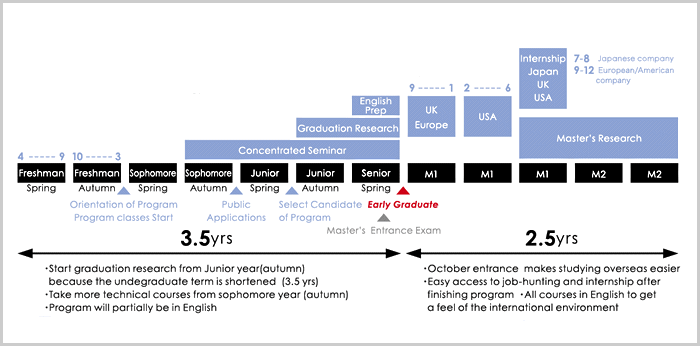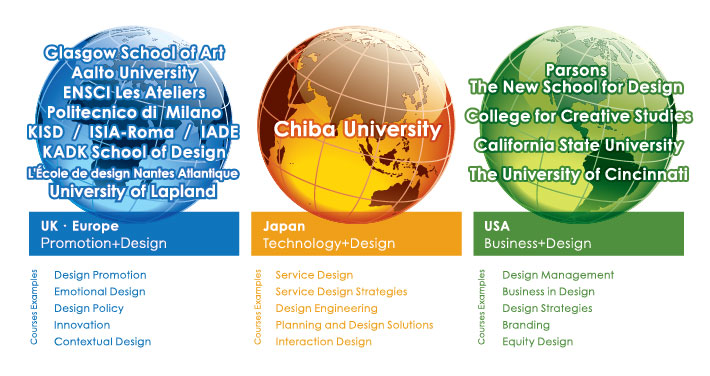General Discription
CODE Program
Continents Design Education Program
Chiba University has launched a new design education program which aims to nurture global designers who could succeed anywhere in the world with the collaboration of 3 different types of design education of USA, Europe, and Japan.
The program aims to nurture a being who will be in the leading position of Japan's future creative industry especially areas in service (computer system and software) and contents of business (game, animation, and products)
The program will recruit promising young students from all over the world of those who are apt to succeed in the creative industry and nurture those students to create the future of the industry.
CODE program provides various types of programs which the students are able to choose one that best suits them
The program is supported by Re-Inventing Japan Project TYPE B-II¦which is one of Ministry of Education, Culture, Sports, Science and Technology's Support Program for Improving University Education adopted in 2011.
¦Type B-II is a program which practices education partnership exchange programs among universities in Europe and Australia aside from America.
Objective
Program Objective
Nurture a professional being who is a candidate-executive in the design division in a Japanese company who creates designs that leads to business in the creative industry (service & content of business) who takes a very important role in Japan's future.
Characteristics
- The program establishes a new academic term that aligns with the international academic calendar which makes studying overseas easier and has less effect on the job-hunting process. Example: Program B7M5: Practice a 6 year program that includes one year of overseas studies. Intensive bachelor's course of 3.5 yrs (Bachelor7 semester)/ Master's course for 1 year in 2 foreign countries(6 months each) and Master's research for 1.5 years(Master's 5 semester).
- The student must go or have a workshop with one or more foreign sister universities to obtain practical experience outside their country. Also, the credits of courses they take overseas will be acknowledged as Chiba University's credit.
Example:
Students of Program B7M5 are required to study design in 3 different countries based on business (USA),promotion (Europe), and technology (Japan).
6 Main Qualities
The program (aside from short-term workshops) establishes high quality courses through an international partnership with foreign universities which guarantee the qualities below.
- Provide some English classes from sophomore year.
- Provide practical education through PBL (Project Based Learning) in the fall semester of sophomore year which is usually taught in master's year.
- Provide classes on present Japanese design before and after studying abroad to learn about the originality of Japanese design.
- Provide presentation based classes and strengthen one's discussion abilities in English.
- Provide connection of the graduation research and master's research in order to continue the same research abroad.
- Provide internship program in and out of Japan at the end of overseas program with university support.
Program Outline Chart
CODE Program B7M5
Objective: To nurture global in-house designers that will succeed in the creative industry University Term: Bachelor 3.5yrs (early graduate)+{Masters 2.5yrs (autumn entrance) Required Credit: Approx. 40 credits (Take 1.5 times more credits from autumn of sophomore year) Research Type: PBL (Project Base Learning)

Partner Univ. and Courses

As for the students of USA and Europe, they will achieve the master's degree by studying total 2 years, one year in their own country and 6 months in other 2 foreign universities.
The master's degree will be issued in their own country but they will receive a certification from the other 2 foreign universities. In other words, students will receive a masters degree and total 3 certifications from 3 different universities. Candidates may study abroad for 6 months twice in their 1st and 2nd year of master's. In the second year, they could experience a long-term internship and have recommendation to Japanese companies in Japan or branches overseas.
The Japanese students will start taking some courses in English from autumn semester of their sophomore year and all courses will be in English in their Master year. This is to prepare an English educational environment for Japanese students who are going abroad and for incoming foreign students.
The required credits are 124 in their bachelor year, same number as a regular bachelor student. In their master year they are required to take 40 credits which is 10 credits more than the regular master's program. (Europe10/USA10/Japan20)
Maximum 30 students are planned to be exchanged in the program every year; 5-10 Japanese students (1 year), 10-20 foreign students (6 months).
In Japan, in-house design is the mainstream thus many Chiba University students become in-house designers.
This made Japan's design rely on technology and the same can be said for the design education curriculum.
On the other hand, America is specially good at developing design for business and applying design as operating assets. For this American universities have many curriculums that focuses on making use of design in business.
As for Europe, they are skilled in promotion design where they focus on the areas where no one has laid hands on and suggest the need for design and also they are brilliant in design development.
By receiving these three very different types of education, the student will acquire a comprehensive design skill of technology, business and promotion.
The program's curriculum is structured by these country's characteristics and having the student cross through the different cultures of each continent and acquire the knowledge of design worldwide, will lead us to the goal of nurturing a global designer.
